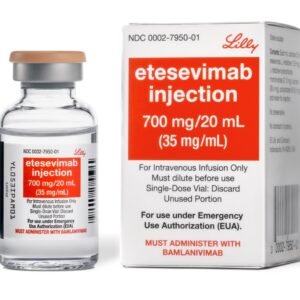Pamiparib Capsules
Function and indication: This product is suitable for the treatment of patients with recurrent advanced ovarian cancer, fallopian tube cancer or primary peritoneal cancer with germline BRCA (gBRCA) mutations who have undergone two or more lines of chemotherapy. This indication is conditionally approved based on the results of an open, multicenter, single-arm, Phase II clinical trial involving 113 patients with recurrent advanced ovarian cancer, fallopian tube cancer or primary peritoneal cancer with gBRCA mutations who have undergone two or more lines of chemotherapy (see [Clinical Trials]). Full approval of this indication will depend on ongoing confirmatory trials confirming the clinical benefit of this product in this population.
Dosage and Administration: This product must be used under the guidance of a physician with experience in anti-tumor treatment. BRCA mutation detection Before using this product for treatment, the test method approved by the State Drug Administration should be used to determine whether the patient has harmful or suspected harmful gBRCA mutations before using this product for treatment. Recommended dose The recommended dose of this product is 60 mg (3 capsules) each time, twice a day, equivalent to a total daily dose of 120 mg. Treatment should be continued until disease progression or unacceptable adverse reactions occur. Dosage Patients are advised to take the drug orally at approximately the same time each day. The capsule should be swallowed whole and should not be chewed, crushed, dissolved or opened. The drug can be taken with or without food. Missed dose If a patient vomits or misses a dose, no additional dose should be taken. The next prescribed dose should be taken as scheduled. Dose adjustment Dose adjustment for adverse reactions To manage adverse drug reactions, treatment suspension or dose reduction may be considered based on the severity of the adverse reaction (see Tables 2 and 3). Recommended dose adjustments are shown in Table 1. 1627457165(1).jpg Monitor complete blood count (CBC). It is recommended to monitor once a week during the first 3 months of treatment and then regularly monitor for changes in clinically significant parameters during treatment (see Table 3). Dose adjustment for non-hematological adverse reactions 1627457219(1).jpg Concomitant use of cytochrome P450 (CYP) 3A inhibitors Concomitant use of strong/moderate/mild CYP3A inhibitors is permitted without dose adjustment (see [Drug Interactions]). Use in special populations Renal insufficiency: No dose adjustment is required for patients with mild to moderate renal impairment. There are no studies on the use of this product in patients with severe renal impairment. This product should be used with caution in patients with severe renal impairment (see [Pharmacokinetics]). Hepatic insufficiency: No dose adjustment is required for patients with mild hepatic impairment. There are no studies on the use of this product in patients with moderate to severe hepatic impairment. This product is not recommended for patients with moderate to severe hepatic impairment (see [Pharmacokinetics]). Children and adolescents: The safety and efficacy of this product in patients under 18 years of age have not been established. Elderly: No dose adjustment is required for elderly patients (≥65 years old) (see [Elderly Use]).
Adverse reactions:
The adverse reactions in this manual describe the approximate incidence of adverse reactions observed in clinical studies that are judged to be possibly caused by pamiparib. Because clinical studies are conducted under different conditions, the incidence of adverse reactions observed in different clinical studies cannot be directly compared and may not reflect the actual incidence in clinical practice. Summary of Safety Profile The safety information of this product comes from three clinical trials (BGB-290-102 [number of patients (N) = 128], BGB-290-AU-002 [N = 101] and BGB-290-201 [N = 88]), involving a total of 317 patients. Tumor types included advanced ovarian cancer (N = 185), breast cancer (N = 101), prostate cancer (N = 12), lung cancer (N = 5), glioblastoma (N = 3), chondrosarcoma and pancreatic cancer (N = 2 each) and adenocarcinoma of unknown primary site, carcinoma of unknown primary site, cervical cancer, gastric cancer, leiomyosarcoma, mesothelioma and uterine cancer (N = 1 each). In the above trials, 256 patients received pamiparib 60 mg/time, twice daily, and 61 patients received other doses of pamiparib. The median exposure duration for all patients (N=317) was 5.5 months (range: 0.1-57.1 months). Among the 317 patients treated with this product, adverse reactions with an incidence of ≥10% included: anemia, nausea, leukopenia, neutropenia, vomiting, fatigue, thrombocytopenia, decreased appetite, diarrhea, abdominal pain, increased aspartate aminotransferase (AST), increased alanine aminotransferase (ALT), increased blood bilirubin, and lymphopenia. The incidence of grade 3 and above adverse reactions was 55.8%, and the incidence of adverse reactions ≥1% included anemia, neutropenia, leukopenia, thrombocytopenia, lymphopenia, vomiting, fatigue, diarrhea, nausea, and increased AST. The incidence of drug-related serious adverse events (SAEs) was 21.5%, and the incidence of drug-related SAEs exceeding 1% was: anemia and leukopenia. Adverse Reactions in Pivotal Clinical Trials The Phase II portion of BGB-290-102 was a pivotal trial conducted in Chinese patients with ovarian cancer, in which a total of 113 patients were treated with pamiparib 60 mg twice daily. The median duration of treatment was 8.3 months (range: 0.1-26.0 months). Adverse reactions with an incidence of ≥ 10% in patients in this trial were: anemia, leukopenia, nausea, neutropenia, vomiting, thrombocytopenia, decreased appetite, fatigue, abdominal pain, ALT increased, diarrhea, AST increased, lymphopenia, gamma-glutamyl transferase increased, upper respiratory tract infection, blood bilirubin increased, malaise, weight loss, and dizziness. The incidence of grade 3 and above adverse reactions was 71.7%, of which the adverse reactions with an incidence of ≥1% included anemia, neutropenia, leukopenia, thrombocytopenia, lymphopenia, vomiting, diarrhea, elevated γ-glutamyl transferase, hypokalemia, abdominal pain, fatigue, upper respiratory tract infection, pancytopenia, and hypertension. The only adverse reaction that led to permanent discontinuation of pamiparib treatment in more than one patient was anemia, with an incidence of 4.4%. For patients in this trial, adverse reactions (incidence ≥ 5%) are summarized in Table 4, and laboratory abnormalities (incidence ≥ 5%) are summarized in Table 5. Table 4: Adverse reactions with an incidence of ≥ 5% in patients treated with pamiparib in the pivotal clinical trial of BGB-290-102a1627457271(1).jpga. Adverse reactions in this manual are defined as adverse events that the investigator judges to be related, possibly related, possibly unrelated, or cannot be determined to be related to the study drug, excluding only adverse events that the investigator judges to be definitely unrelated. The data cutoff date is August 24, 2020. b. The preferred terms are based on the Chinese version of ICH International Medical Terminology Dictionary (MedDRA) 23.0. c. The severity of adverse reactions is graded according to NCICTCAE v4.03. d. There were no grade 5 adverse reactions in this study. The following terms represent a group of related events describing a certain condition, not a single event. 1. Includes anemia, decreased hemoglobin, erythropenia, and decreased red blood cell count. 2. Includes leukopenia and decreased white blood cell count. 3. Includes neutropenia and decreased neutrophil count. 4. Includes thrombocytopenia and decreased platelet count. 5. Includes lymphopenia and decreased lymphocyte count. 6. Includes abdominal distension, abdominal pain, upper abdominal pain, lower abdominal pain, abdominal tenderness, upper abdominal discomfort, and abdominal discomfort. 7. Includes fatigue and weakness. 8. Includes hyperglycemia and increased blood glucose. 9. Includes hyperuricemia and increased blood uric acid. 10. Including upper respiratory tract infection, viral upper respiratory tract infection. 11. Including nasopharyngitis, oropharyngeal pain, nasal inflammation, nasal congestion, nasal congestion. 12. Including dizziness, vertigo, postural dizziness. 13. Including palpitations, tachycardia, sinus tachycardia. Table 5: Treatment-related laboratory abnormalities with an incidence of ≥ 5% in patients treated with pamiparib in the pivotal clinical trial of BGB-290-102a1627457344(1).jpga. Laboratory abnormalities in this manual are defined as adverse events that the investigator judges to be related, possibly related, possibly unrelated, or unable to be determined to be related to the study drug, excluding only adverse events that the investigator judges to be definitely unrelated. The data cutoff date is August 24, 2020. b. The preferred terms for laboratory tests are based on the Chinese version of the ICH International Medical Terminology Dictionary (MedDRA) 23.0. c. The severity of adverse reactions is graded according to the NCICTCAE v4.03. d. There were no grade 5 related laboratory abnormalities in this study. The following terms represent a group of related events describing a condition, rather than a single event. 1. ALT = alanine aminotransferase; AST = aspartate aminotransferase. 2. Includes increased blood bilirubin, hyperbilirubinemia, increased conjugated bilirubin, and increased blood unconjugated bilirubin. Description of important adverse reactions Hematological toxicity In all three clinical trials, 317 patients received pamiparib monotherapy, with a total incidence of hematological adverse reactions of 74.1%, and the incidence of grade 3 and 4 hematological adverse reactions of 46.4%. The incidence of anemia was 69.1%, and 34.7% of patients had grade 3 or 4 anemia, of which 23.3% required blood transfusion. The median time to the first onset of ≥ grade 3 anemia was 57.0 days (range: 7-419 days), and the cumulative median duration was 11.0 days (range: 2-35 days). The incidence of dose interruption, dose reduction, and discontinuation of treatment due to anemia was 48.9%, 36.6%, and 2.2%, respectively. The incidence of neutropenia was 50.8%, and 26.8% had grade 3 or 4 neutropenia. The median time to the first occurrence of ≥ grade 3 neutropenia was 45.0 days (range: 21-567 days), and the cumulative median duration was 5.0 days (range: 2-47 days). The incidence of dose interruption, dose reduction, and discontinuation of treatment due to neutropenia was 22.7%, 6.3%, and 0.3%, respectively. The incidence of leukopenia was 53.0%, and 18.9% had grade 3 or 4 leukopenia. The median time to the first occurrence of ≥ grade 3 leukopenia was 44.0 days (range: 21-419 days), and the cumulative median duration was 4.0 days (range: 2-35 days). The incidence of dose interruption, dose reduction, and discontinuation of treatment due to leukopenia was 10.7%, 4.1%, and 0.3%, respectively. The incidence of thrombocytopenia was 31.9%, and 7.3% had grade 3 or 4 thrombocytopenia. The median time to the first occurrence of ≥ grade 3 thrombocytopenia was 35.0 days (range: 5-624 days), and the cumulative median duration was 8.0 days (range 4-22 days). The incidence of dose interruption and dose reduction due to thrombocytopenia was 7.6% and 3.2%, respectively, and there was no discontinuation of treatment due to thrombocytopenia. Gastrointestinal toxicity Among the 317 patients receiving pamiparib monotherapy, the overall incidence of gastrointestinal adverse reactions was 78.2%, the incidence of grade 3 gastrointestinal adverse reactions was 7.3%, and no grade 4 and 5 gastrointestinal adverse reactions occurred. The incidence of nausea was 61.2% (1.6% for grade 3), and the median time from enrollment to the first occurrence of nausea was 4 days (range: 1-174 days). The vast majority of patients had grade 1 nausea, and the incidence of medication suspension and dose reduction due to nausea was 6.9% and 1.6%, respectively. Only 1 patient (0.3%) had permanent discontinuation due to nausea. The incidence of vomiting was 36.6% (2.5% for grade 3), and the median time from enrollment to the first occurrence of vomiting was 5 days (range: 1-454 days). The vomiting of most patients was grade 1, and the incidence of suspension and reduction of medication due to vomiting was 4.1% and 1.9%, respectively. Only 1 patient (0.3%) had permanent discontinuation due to vomiting. Nausea and vomiting of grade ≥2 can be controlled by interruption of treatment, reduction of dosage and/or antiemetic treatment.
Contraindications:
Contraindicated for patients who are allergic to the active ingredients of the drug or any excipients. Stop breastfeeding during treatment and within 1 month after the last dose (see [Use in Pregnant and Lactating Women]).
Share:
Products
Our offers
Health Classification
Let us work together to protect precious health



























